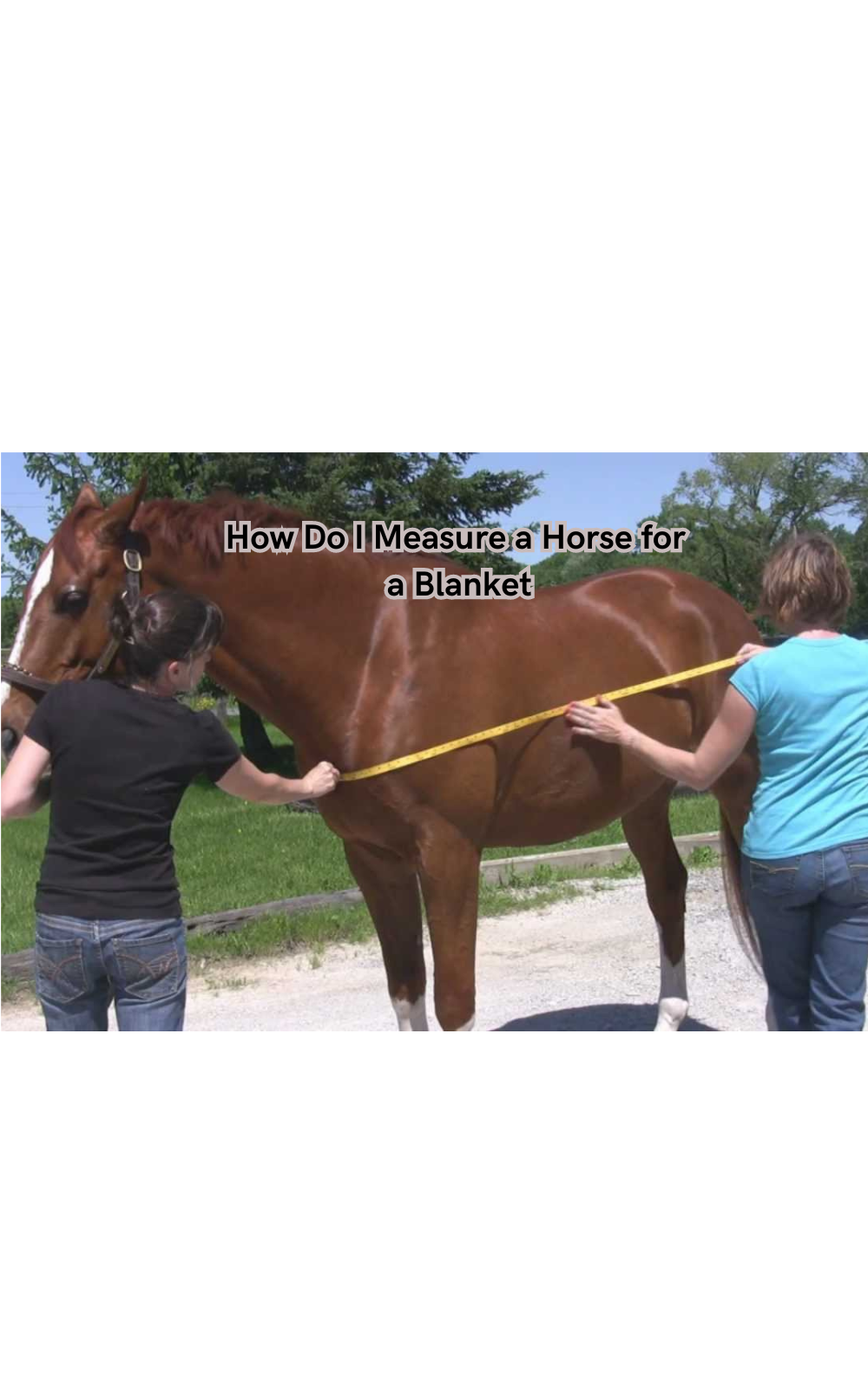How Do I Measure a Horse for a Blanket
By adhering to these measurement guidelines, you can select a blanket that not only fits snugly but also allows for unrestricted movement, enabling your horse to stay warm and content in any weather condition.

When it comes to ensuring the comfort and protection of your equine companion, correctly measuring a horse for a blanket is paramount. A well-fitting blanket shields horses from the elements and improves their health and happiness.
To obtain the ideal blanket size, precise measurements are critical. Using a pliable tape measure and a calm horse, you can determine the appropriate dimensions by gauging the length from chest to tail, the width across the shoulders, and the girth around the belly.
By adhering to these measurement guidelines, you can select a blanket that fits snugly and allows unrestricted movement. This will enable your horse to stay warm and content in any weather condition.
Understand your Need for Blanket
First and foremost, it's essential to understand why your horse needs a blanket. While horses can naturally regulate their body temperature, there are certain circumstances where an extra layer of protection is necessary.
For example, if your horse has been clipped or has a thin coat, they may require additional warmth during colder months. Additionally, if your horse is older, sick, or recovering from an injury, a blanket can aid in maintaining a consistent body temperature and promoting healing.
Blankets are also helpful in keeping horses clean before shows or events and protecting them from insects during the summer months. It is crucial to consider these factors when choosing a blanket and determining the appropriate size.
Why is Horse Blanket Fit Important?
A properly fitting horse blanket is crucial for several reasons. First and foremost, an ill-fitting blanket can cause uncomfortable rubbing and chafing on your horse's skin, leading to irritation and potential injuries.
Moreover, a too-tight blanket can restrict movement, preventing horses from engaging in essential behaviors such as rolling or stretching. It can also impede blood circulation, potentially causing health issues. Conversely, a too-loose blanket can be hazardous, as horses may trip or get tangled in excess material.
Types of Horse Blankets
Several types of horse blankets are available in the market, each designed for different purposes. It's essential to consider your horse's needs and environment when selecting a blanket type. Some standard options include:
- Turnout Blankets: These are made from waterproof material and protect from rain, snow, and wind. They are ideal for horses living outdoors or those participating in winter activities.
- Stable Blankets: These blankets are designed for indoor use and provide warmth without the added waterproofing. They are suitable for horses living in stalls or those with a thick natural coat.
- Fly Sheets: These lightweight blankets protect horses from insects during the summer months and provide some UV protection. They are typically made from breathable mesh material to prevent overheating.
How Do I Measure a Horse for a Blanket
To accurately measure your horse for a blanket, follow these simple steps:
Gather Things:
- A flexible soft measuring tape
- A helper, if possible
- A pen and paper to record measurements
Length:
Stand your horse square. Start by standing on your horse's left side and locating the center of their chest. From there, measure straight back to the edge of their tail while ensuring the tape measure is flat against their body. Horsetail lengths vary, so measure up to the tail's edge and not the end of the hair. Write down this measurement in inches.
Horse blanket size is typically based on length, so if your horse measures 70 inches from chest to tail, it will likely need a size 70 blanket. Horse owners also have the option to measure from chest to withers (the base of the neck) for a more precise fit, especially if their horse has a shorter or longer back than average.
Width:
To obtain the width measurement, locate the point on your horse's shoulder where you would like the blanket to sit comfortably. Measure straight across to the same point on their right shoulder. Horse chest sizes can vary, so measuring this area accurately is essential.
Heavy-weight blankets typically have a broader chest and shoulder area than lightweight blankets. Be sure to consider this when choosing the appropriate size. Inches measurement should be written down.
Girth:
Finally, wrap the tape measure around your horse's belly at its widest part, ensuring it is snug but not too tight. Tail straps or elastic leg straps typically compensate for any slight variation in the girth measurement. Exact-size blanket girth measurements are usually listed in inches, so record your measurements accordingly.
Once you have these measurements, refer to the manufacturer's sizing chart to determine the appropriate blanket size for your horse. Remember that each brand may have slightly different measurements, so it's always best to double-check before purchasing.
How to Use a Horse Blanket
Once you have the right size and type of blanket for your horse, you must know how to use it correctly. Here are some tips for using a horse blanket:
- Adjust Straps: Make sure all straps are adjusted appropriately so that the blanket fits snugly but comfortably on your horse. The chest should be closed enough to prevent rubbing but not too tight to restrict movement.
- Check Regularly: It's crucial to regularly check your horse's blanket, especially during the first few days of use. This will allow you to spot any potential issues, such as rubbing or twisting, and adjust accordingly.
- Remove When Necessary: Blankets should be removed daily for grooming and inspection, allowing you to check your horse's skin for irritation or injuries. Removing blankets if they get wet is essential, as a soaked blanket can cause discomfort and even hypothermia in cold weather.
- Store Properly: When unused, blankets should be stored in a dry, well-ventilated area to prevent mildew and odors. Also, thoroughly dry your blankets before storing them for the season.
Blankets can be valuable tools in keeping horses comfortable, healthy, and protected in various weather conditions. Cold weather, rain, and insects can all affect a horse's well-being, so having the appropriate blanket on hand is essential.
How to Use a Horse Blanket
Once you have the right size and type of blanket for your horse, you must know how to use it correctly. Here are some tips for using a horse blanket:
- Adjust Straps: Make sure all straps are adjusted appropriately so that the blanket fits snugly but comfortably on your horse. The chest should be closed enough to prevent rubbing but not too tight to restrict movement.
- Check Regularly: It's crucial to regularly check your horse's blanket, especially during the first few days of use. This will allow you to spot any potential issues, such as rubbing or twisting, and adjust accordingly.
- Remove When Necessary: Blankets should be removed daily for grooming and inspection, allowing you to check your horse's skin for irritation or injuries. Removing blankets if they get wet is essential, as a soaked blanket can cause discomfort and even hypothermia in cold weather.
- Store Properly: When unused, blankets should be stored in a dry, well-ventilated area to prevent mildew and odors. They should also be thoroughly dried before being stored for the season.
Blankets can be valuable tools in keeping horses comfortable, healthy, and protected in various weather conditions. Cold weather, rain, and insects can all affect a horse's well-being, so having the appropriate blanket on hand is essential.
Tips for Choosing the Right Horse Blanket
With so many options available, knowing which blanket is best for your horse can be challenging. Here are some tips to keep in mind when selecting a horse blanket:
- Consider Climate: Your region's climate and weather conditions should play a significant role in choosing the right blanket for your horse. For example, if you live in a colder climate, you may need a heavy-weight turnout blanket, while a lightweight fly sheet may be more suitable for warmer areas.
- Assess Your Horse's Needs: Consider your horse's living situation and lifestyle when selecting a blanket. Horses that spend most of their time outdoors will likely benefit from a waterproof turnout blanket, while those living indoors may only require a stable blanket for added warmth.
- Think About Fit: A properly fitting horse blanket should allow for comfortable movement and prevent rubbing or slipping. Measure your horse accurately before purchasing a blanket, and consider trying it on before committing to ensure a perfect fit.
- Invest in Quality: High-quality blankets may cost more upfront but are often made with better materials and construction, resulting in a more durable and long-lasting product. Investing in a quality blanket can save you money in the long run by reducing the need for frequent replacements.
FAQs
What is the most common horse blanket size?
The most common horse blanket size is usually between 70-84 inches, depending on the horse's height and build. Plus-size horses may require larger sizes.
How often should I check my horse's blanket?
It's essential to check your horse's blanket regularly, at least once a day, during the first few days of use. After that, checking every other day or so should be sufficient unless there are noticeable changes in weather conditions.
What is a 1200d horse blanket?
The "d" in 1200d horse blanket refers to the denier of the fabric used. Denier is a unit of measurement for the fineness of individual fibers, and 1200d means that the fabric is made up of yarns with a linear density of 1200 grams per 9000 meters.
When should you blanket a horse?
Horses should be blanketed when the weather conditions call for it. This may include cold temperatures, rain, or insects. It's essential to monitor your horse's comfort and well-being and adjust their blankets accordingly.
Conclusion
In conclusion, measuring a horse for a blanket is a fundamental step in equine care and welfare. By meticulously determining the correct dimensions for a blanket, you ensure optimal comfort and protection for your horse and demonstrate a commitment to their well-being.
Accurate measurements, taken with care and precision, enable you to select a blanket that fits snugly yet allows for freedom of movement, essential for your horse's overall happiness and health.
Embracing this practice of measuring for a blanket underscores your dedication to providing your equine companion with the utmost care and attention to detail. With a well-fitted blanket, your horse can comfortably weather various conditions, fostering a contented and thriving partnership between you and your four-legged friend.
